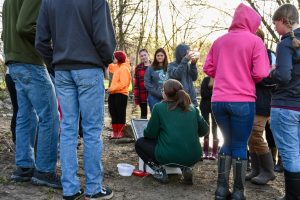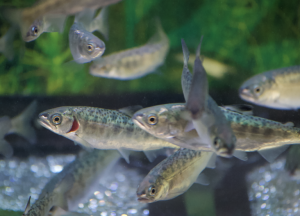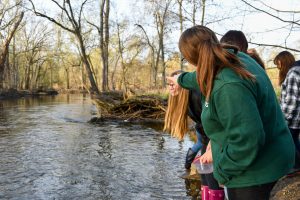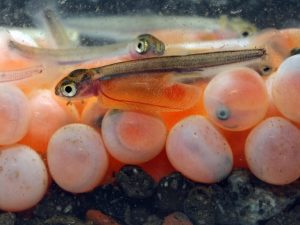 Imagine standing by the serene Red Cedar River on a picturesque April day, surrounded by excited students clutching small containers. Inside those containers are Chinook salmon smolts, poised for their release into the wild. This unforgettable moment marks the culmination of months of dedication and care through the “Salmon in Classroom” (SIC) program. Implemented in over 300 classrooms across Michigan and overseen by the Department of Natural Resources (DNR), the SIC program provides a unique opportunity for students to raise Chinook salmon from eggs, witnessing their growth and development firsthand.
Imagine standing by the serene Red Cedar River on a picturesque April day, surrounded by excited students clutching small containers. Inside those containers are Chinook salmon smolts, poised for their release into the wild. This unforgettable moment marks the culmination of months of dedication and care through the “Salmon in Classroom” (SIC) program. Implemented in over 300 classrooms across Michigan and overseen by the Department of Natural Resources (DNR), the SIC program provides a unique opportunity for students to raise Chinook salmon from eggs, witnessing their growth and development firsthand.
 One of the institutions embracing the SIC program is Potter Park Zoo, in cooperation with the Eaton RESA Career Preparation Center. Potter Park Zoo hosts Animal Science and Zoo Management Courses for local 11th and 12th-grade students through the Career Preparation Center, and the SIC program perfectly aligns with the zoo’s conservation goals. Educator Rebecca Morningstar emphasizes how the program provides an excellent learning opportunity, enabling students to explore the importance of ecosystem balance, engage in hands-on stewardship, and develop a deep understanding of caring for aquatic species.
One of the institutions embracing the SIC program is Potter Park Zoo, in cooperation with the Eaton RESA Career Preparation Center. Potter Park Zoo hosts Animal Science and Zoo Management Courses for local 11th and 12th-grade students through the Career Preparation Center, and the SIC program perfectly aligns with the zoo’s conservation goals. Educator Rebecca Morningstar emphasizes how the program provides an excellent learning opportunity, enabling students to explore the importance of ecosystem balance, engage in hands-on stewardship, and develop a deep understanding of caring for aquatic species.
The exciting journey of the Chinook salmon starts in early November when fertilized eggs are carefully collected from a nearby DNR hatchery and placed in the classroom tank. Taking on the responsibility of nurturing their young charges, Ms. Morningstar and her students dedicate themselves to ensuring the well-being of the eggs. They undertake routine cleaning, monitor for harmful substances and ammonia buildup, and maintain suitable water conditions. Within a few weeks, the eggs hatch into alevins, tiny vulnerable salmon less than an inch long, reliant on their yolk sacs for nourishment. Over the next few months, with diligent feeding, the young salmon progresses through the “fry” and “parr” stages, growing and developing their distinctive vertical stripes. After approximately six months, the juveniles assume their silver coloration, signaling their transformation into smolts and their readiness for an incredible downstream journey.
 Beyond tending to their salmon, SIC students also delve into the rich history of Chinook salmon in Michigan. In the 1960s, the DNR introduced this species to combat an invasive fish called the alewife. Originally from the Atlantic coast, the alewife made its way into Michigan’s lakes through human-made canals. Its rapid proliferation, paired with the decline in large native fish species caused by invasive sea lamprey, led to ecosystem disruption and massive die-offs that posed a nuisance to lake residents and tourists. However, the introduction of Chinook salmon brought balance to the ecosystem. Through predation, the salmon successfully controlled the invasive alewife population. Since then, Chinook salmon have thrived in Michigan’s rivers and lakes, helping maintain a healthier and more stable aquatic environment.
Beyond tending to their salmon, SIC students also delve into the rich history of Chinook salmon in Michigan. In the 1960s, the DNR introduced this species to combat an invasive fish called the alewife. Originally from the Atlantic coast, the alewife made its way into Michigan’s lakes through human-made canals. Its rapid proliferation, paired with the decline in large native fish species caused by invasive sea lamprey, led to ecosystem disruption and massive die-offs that posed a nuisance to lake residents and tourists. However, the introduction of Chinook salmon brought balance to the ecosystem. Through predation, the salmon successfully controlled the invasive alewife population. Since then, Chinook salmon have thrived in Michigan’s rivers and lakes, helping maintain a healthier and more stable aquatic environment.
The story of the Chinook salmon exemplifies the vital importance of wildlife research and highlights humanity’s capacity to both harm and heal the natural world. By actively engaging students in this delicate relationship through the SIC program, a profound sense of purpose and awareness is instilled within them. They are encouraged to seek out new connections in the world around them and reflect upon life’s intricate and ever-changing equilibrium. SIC empowers students to become stewards of the environment, promoting the understanding that their actions can positively impact our planet’s delicate ecosystems.
 As the smolts are released into the Red Cedar River, a new chapter begins for these resilient Chinook salmon. Over the following months, they embark on an extraordinary downstream odyssey toward the Great Lakes. In this vast aquatic playground, they will grow and thrive for up to eight years, adapting to the challenges and wonders of their environment. Eventually, when the time is right, these mighty salmon will undertake their final and most awe-inspiring leg of the journey—returning upstream to their birthplace. Guided by instinct, they will navigate formidable obstacles, leap over cascading waterfalls, and conquer long distances to complete their life cycle, perpetuating the legacy of their species. It is a testament to the remarkable resilience and endurance of these incredible creatures and a reminder of the interconnectedness of all living beings in the delicate tapestry of our natural world.
As the smolts are released into the Red Cedar River, a new chapter begins for these resilient Chinook salmon. Over the following months, they embark on an extraordinary downstream odyssey toward the Great Lakes. In this vast aquatic playground, they will grow and thrive for up to eight years, adapting to the challenges and wonders of their environment. Eventually, when the time is right, these mighty salmon will undertake their final and most awe-inspiring leg of the journey—returning upstream to their birthplace. Guided by instinct, they will navigate formidable obstacles, leap over cascading waterfalls, and conquer long distances to complete their life cycle, perpetuating the legacy of their species. It is a testament to the remarkable resilience and endurance of these incredible creatures and a reminder of the interconnectedness of all living beings in the delicate tapestry of our natural world.
The “Salmon in Classroom” program has not only empowered students to be active participants in environmental stewardship but has also helped maintain balance in Michigan’s ecosystems. Through their experiences, these young individuals have gained a profound appreciation for the intricate web of life, inspiring them to cherish and protect our natural heritage for generations to come.
Nearly 300 animals call Potter Park Zoo home, including critically endangered black rhinos, endangered red pandas, Massasauga rattlesnake and spider monkeys. The zoo is located in Lansing, Michigan, and is open 364 days a year. For more information, visit www.potterparkzoo.org.




